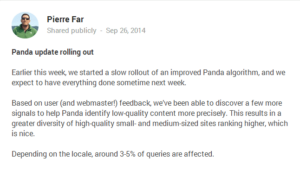Attention: Digital marketing Philippines providers. Let us not forget that Panda was initially created to penalize low-quality contents from poorly written to thin to duplicate to irrelevant to spammy contents. Put simply, Panda aims to weed out bad contents since they are bad for user experience (UX) and reward strong contents. Here is our take on the recent Panda update dubbed as the Panda 4.1.
What is Google Panda 4.1 update?
Four months and four days after Google rolled out Panda 4.0, the search giant slowly rolled out Panda 4.1 (September 25th), a name given by the Search Engine Land. Panda 4.1 is a minor yet more impactful than other minor updates and less significant than major updates known as Panda 1.0, 2.0, 3.0 and 4.0.
Panda 4.1 targets just that – low-quality contents, giving small and medium-sized websites to rank higher in the search engine results pages (SERPs). In fact, Panda 4.1 affected around 3 to 5% of search queries through adding new signals to detect low-quality contents. Surely, Google is not going to publicize what those signals are.
Google confirmed that Panda 4.1 is still on a slow rollout. However, it is not sure when the rollout will be completed although it is said that it will only run for a couple of weeks (until 1st week of October) from the date of its announcement.
What does the update mean?
A LOT. If your website was penalized by Panda 4.0 or other updates ahead of that, now is the chance to recover if the right changes are implemented. Conceivably, you are now seeing an overall increase in your traffic on the day or even after a few days from the date of the update implementation. Even if your site is not penalized by Google whatsoever, if you actively publish high-quality contents, your website should realize better rankings. This means Google thinks of your contents as acceptable.
Unfortunately, if you are seeing an overall decrease in your traffic (as in sudden drops in traffic in the last two to three weeks), chances are, Panda 4.1 hits your website. This means that the strategies and changes (for recovering sites) implemented are not up to Google’s standards.
People are constantly trying to outsmart Google’s algorithms including Panda. On the other hand, Google is persistently making its algorithms sophisticated. There are at least three things that the new update is working towards:
- Better refining search engine optimization (SEO) strategies
- Providing searchers with more accurate results
- Trying to eliminate black hat SEO strategies
Who are the winners and losers?
Less than a month after it was announced and implemented, Search Metrics already has a list of winners and losers in the US.
Winners
comdotgame.com
hongkiat.com
babble.com
mediamass.net
hotelguides.com
spoonful.com
acesshowbiz.com
womansday.com
allwomenstalk.com
savings.com
health.com
newmuseum.org
netdoctor.co.uk
digitaltrends.com
quickanddirtytips.com
simplyrecipes.com
glamour.com
parenting.com
webopedia.com
smithsonianmag.com
thefreedictionary.com
Losers
yellow.com
free-coloring-pages.com
office365.com
adelaide.edu.au
socialcomments.org
discountsstory.net
studymode.com
appappeal.com
chronicle.com
hubpages.com
medterms.com
thinkbabynames.com
theepochtimes.com
buzzle.com
howstuffworks.com
oxforddictionaries.com
hallmark.com
ehow.com
miamiherald.com
mommysavesbig.com
Evidently, the winners and losers are so diverse we can only assume that the losers have ‘thin’ contents and the winners have ‘thick’ contents. Case in point: some of the losers are aggregators that, in the most part, do not provide unique and relevant contents.
From the list above, there are websites that were penalized by Panda 4.0 and rewarded by Panda 4.1. Examples of these sites are babble.com, hotelguides.com, simplyrecipes.com, and glamour.com.
Anyhow, the focus of Panda is content quality. We can easily presume that the winners won since they update their sites with new and relevant contents regularly. The losers lost because the websites include the same exact contents as other sites in their respective industries.
What should you do if you were hit by Panda 4.1?
While it may take time before you will recover fully from the unfavorable impact of Panda 4.1, you can start by doing these.
1) Review the content strategy
Conduct a content audit more so if you worry that Google may penalize your site in the future. Make adjustments NOW. Take a look at your competitors’ websites. Check if they have been hit or not. If not, identify factors why their websites were not hit, and your site was. Focus on what their content strategies are that are working for their favor. For instance, look at the frequency of updating their blogs, originality of the information presented, depth of discussion, etc. You may mimic their strategies, but do it better by incorporating fresh tactics into the strategies.
2) Delete thin and duplicate content
Check your contents. If there are contents that are quotes-based or dependent on external sources, might as well remove them. Run your website in a plagiarism software. Then, remove all plagiarized contents or repurpose them. For example, reword the contents suitable for an infographic. Aside from removing duplicates, create high-quality contents then avoid publishing ‘thin’ contents. Be relevant.
3) Diversify the content distribution portfolio
Look for legit ways that can provide value to your SEO in general. Don’t stick to a single method unless you want Google to think that your website is unimportant. Have you tried guest posting? What about creating an infographic? These processes are very helpful in generating targeted traffic to your main website. Whatever you choose, make your expertise and experience shine through the contents you write and publish on other platforms. Aside from this, these are great link building opportunities.
Again, if you do your contents right, you will see an overall increase in ranking by the next update, which no one knows when exactly. READ SOMEWHERE: Based on the current spacing between updates, we can assume that Google is trying to update its Panda algorithms on a quarterly basis. So, we can expect Panda 4.2 or Panda 5.0 (or whatever you want to call it) in December 2014 or January 2015.
The only certain thing now is that Google will continue to update Panda and other algorithms. Our primary concern is when and what ranking signals will be introduced or eliminated in the future. Despite that, contents you publish on the web should be original and valuable to the readers as possible.
Sources: Searchmetrics | Search Engine Land | Huffington Post | ProBlogger
Image credit: Increase My Online Business





